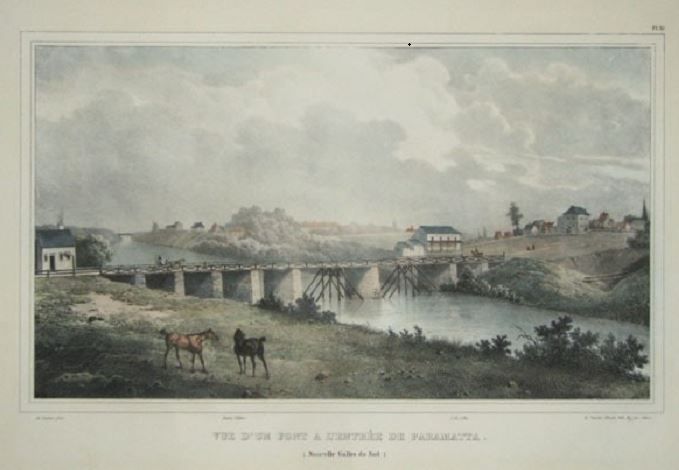
Second ridge over the Parramatta River. From the first voyage of Dumant D’ville, Voyage de la corvette l’Astrolabe, published Paris 1833, Plate 33
Parramatta Gaol Bridge is one of Australia’s first bridges. The remnants of this bridge is buried inside Lennox Bridge.
In 1794, first wooden bridge was constructed over the Parramatta river connecting the Parramatta Gaol (then at Prince Alfred square site) and Church Street. In 1795, this wooden bridge was swept away by floodwater.
In 1796, the first wooden bridge was replaced by second bridge constructed of timber girders on stone piers. In 1802 two stone bridge piers were replaced by timber trestles.
The decking of the bridge was supported on ten sandstone piers. It was of timber and included a guard-rail or balustrade on either side that comprised drop posts with top and bottom rails with each section infilled with timber diagonals.
It was said that ‘even when a horse cantered over it, the bridge would shake’. Stockmen told of cattle falling over the sides on being herded across the bridge, as apparently balustrading was missing. Piers supporting the two longer spans on the northern side were now missing and these spans had to be strengthened with trestles of hardwood posts which were braced with diagonals against the feet of the existing stone piers.
The Parramatta Gaol Bridge has a great historical significance as it was the first major crossing of the Parramatta River to join the southern and northern section of the new colony at Parramatta.
The wooden bridge was built on the site of the Lennox Bridge and had a crossing span at Church Street which gave access between the town and the gaol. It also helped to open up access to the growing settlements to the north of Parramatta River.
Floodwaters in 1826 severely damaged three of the piers and, with one being rebuilt in late 1827, the bridge managed to survive until 1837.
On August 1, 1832 David Lennox arrived in Sydney. A few months later, he was appointed Sub-Inspector of Roads followed by Superintendent of Bridges in 1833. He reported on the deteriorating Condition of second bridge at Parramatta. Submitting plans for a replacement structure, as the wooden bridge was by that time in a very insecure state. On November 23, 1836 the foundation stone of a new bridge (now the Lennox Bridge) was laid by Governor Bourke and part of the bridge was opened in 1837.
![]()
Neera Sahni, Research Services Leader, Parramatta Heritage Centre, city of Parramatta, 2021
References
- James Jervis, The Cradle City of Australia: History of Parramatta 1788-1961, Sydney, Parramatta City Council, 1961
- Pollon, Frances, Parramatta, the Cradle City of Australia: its history from 1788, Sydney, Parramatta City Council, 1983.
- Sydney Gazette, 22 Nov 1827.
- Terry Kass et al, Parramatta, A Past Revealed, Parramatta City Council, 1999


